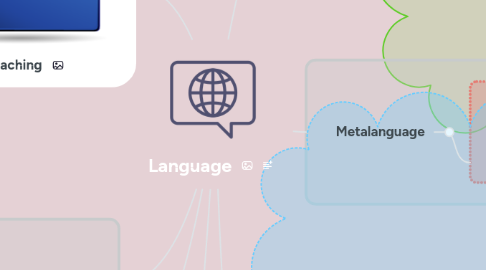
1. Resourse: Making meanings in social contexts.
1.1. Encoded in lexicogrammar (wordings)
1.2. Unified into whole units of meanings (texts)
1.3. Motivated by what is going on in te world outside the text (context)
1.3.1. 2 Levels: General level of culture and an immediate level of situation
2. Two levels
2.1. A level of content (semantics) and (lexicogrammar). A level of expression: wordings expressed as sounds.
3. Text-based approach
3.1. Social Context
3.1.1. Field
3.1.1.1. TECHNICALITY --------- COMMON SENSE
3.1.2. Tenor
3.1.2.1. POWER
3.1.2.1.1. EQUAL ------------ UNEQUAL
3.1.2.2. CONTACT
3.1.2.2.1. FRECUENT --------------- OCCASIONAL
3.1.2.3. AFFECTIVE INVOLVEMENT
3.1.2.3.1. HIGH --------------- LOW
3.1.3. Mode
3.1.3.1. a) Spatial/interpersonal distance casual conversation telephone e-mail fax radio novel +visual contact - visual +aural - aural +immediate feedback - feedback
3.1.3.2. b) Experiential distance Playing a game commentating reporting an experience constructing experience Language as action Language as reflection ORAL WRITTEN TURN BY TURN SEQUENCING MONOLOGIC BLOCK CONTEXT DEPENDENT CONTEXT INDEPENDENT
4. Teaching
4.1. Systemic functional linguistics
4.1.1. Abstract: Extra linguistic level ----------------Concrete: More linguistic level
4.1.2. Context of culture
4.1.3. Context of situation
4.1.4. Discourse semantics
4.1.5. Lexicogrammar
4.1.6. Graphology- phonology
4.2. Whole texts in context
5. Systemic functional Linguistics
5.1. Learning language
5.1.1. Interested in social phenemena
5.1.1.1. The meanings the learners make with the language
5.1.1.2. What the learners want or need to do with the language
5.1.1.3. The social contexts in which the learner use the language
5.2. Halliday
5.2.1. Meaning
5.2.1.1. Interactive process
5.2.2. Learning to mean and to expand one´s meaning potential
5.2.2.1. The content of language program is organised around the teaching of the whole texts in context.
5.2.3. Students are involved:
5.2.3.1. Learning language
5.2.3.2. Learning about language
5.2.3.3. s
5.2.4. Learning through language
5.3. Vigotsky
5.3.1. Human beings construct konwledge:
5.3.1.1. Colaboration
5.3.1.1.1. The teacher and the learner share responsability for functioning, until the learner has the knowledge.
5.3.1.2. Scaffolding
5.3.1.2.1. The teacher contributes explicitly what learners are not yet able to do, adjusting their contribution as learners became independent.
6. Metalanguage
6.1. Teachers and students build collaborately a systematic and a comprehensive body of knowledge which can be applied to the study of language and its use.
7. Cyrcle of teaching and learning
7.1. Context exploration
7.1.1. • Cultural knowledge • Knowledge about the social activity and subject matter • Knowledge about the roles and relationships of those communicating • Knowledge about the means of communication and how it is used
7.2. Explicit Instruction
7.2.1. • Introduction to model texts • The teacher shows how meanings in the text are: - Shaped by the context in which they are used. - Unified by texture and structure. - Encoded in lexicogrammar • Introduction of metalanguage
7.3. Guided Practice
7.3.1. • Strategies to guide students build knowledge about context. • The teacher and the other students, construct a text, explicitly discussing and negotiating meaning
7.4. Independent Application
8. Assesment
8.1. Consider
8.1.1. 1. The purpose and the context
8.1.2. 2. The overall organization of the text
8.1.3. 3. How cohesive of the text is and how cohesion is achieved
8.1.4. 4. The significant grammatical features in the text
8.1.5. 5. Vocabulary choiceds in the text
8.1.6. 6. The layou and script
8.1.7. • Students can plan and undertake their own research and construct their own texts. • As students move through the cycle, they gradually approximate control of the different aspects of the text type, the text structure, grammar and vocabulary, pronunciation of spoken texts, surface feature of written texts.
8.2. Checklist for texts
8.2.1. Text unity
8.2.2. Clause grammar
8.2.3. Groups/words
8.2.4. Graphology
